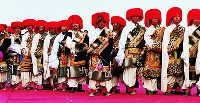|
Duixie Dance
( 2005-10-17 )

Duixie is a popular collective folk dance in the western part of Southwest China's Tibet Autonomous Region. Dui, which means "upper" or "highland," refers to the round dance popular in rural areas of Ngamring, Dingri, Lhaze, and Sagya counties on the upper reaches of theYarlung Zangbo River, while Xie means "songs."
Duixie later became a cheerful and enthusiastic folk dance popular throughout Tibet, and later, after improvement by actors and dancers, evolved into a kind of urbanized Tibetan tap dance. Most popular on the streets and in the open squares and Lingkas (parks) inLhasa, this dance is also known as the Lhasa Tap Dance.
The tap dance that has evolved from the rural Duixie Dance is a complex combination of a change of movement after every three steps -- five, seven, and nine quick mark-time steps with turns. The taps are rhythmic.
As is recorded, in the mid-seventeenth century the fifth Dalai, in an effort to reinforce his rule by combining government with religion, stipulated that the Shoton Festival be held in Lhasa from the end of June to early July every year. (The Shoton Festival later developed into the Tibetan drama festival.)
One day during a Shoton Festival, groups from all parts of Tibet converged on the capital city of Lhasa to perform. A group from the Dui area in Tibet performed a lively and vigorous tap dance that was immediately loved and improved on by people in Lhasa. The major improvement was to start on the second beat, followed by a change of step after every three steps.
In Duixie Dance, the dancers tap vigorously to music played on flutes, Chinese plucked stringed instruments, plucked six-stringed instruments, dulcimers, and clusters of small bells.
The music for accompaniment of Duixie has been formalized into a slow opening, short interlude, allegro, and finale. Thus Duixie has gradually been transformed from a recreational dance into stage exhibition.
|

